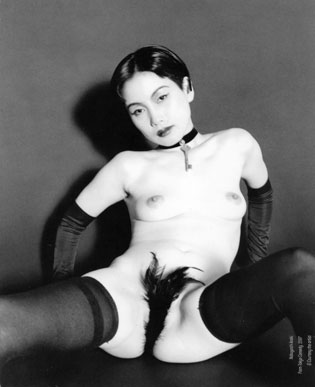


|
Paroxysm - Punctum - Studium - ça-a-été - denotation - connotation and Roland Barthes and Nobuyoshi Araki. |
|

What
distinguishes an erotic photograph of a pornographic?
The
pornography usually shows the genus, it turns it into a
motionless object, a fetish. The erotic photo on the other hand
does not make the genitals the main object; she cannot show this
either. What is not seen, is equally important.
The
spectator is carried out under the photo and faces his
own fantasies, dreams, passions, ...
On
the night of September 24, 2006, vandals daubed the giant photo
of Japanese photographer Nobuyoshi Araki mounted on the facade
of the Museum of Photography in Charleroi. The picture with the
paint spots now hangs as a trophy in the garden of the Carmelite
monastery where the museum is housed.
What
is there to see in the picture "From Tokyo Comedy"? What is its
denotation? A young woman, knees apart, is looking at us.
She wears a collar with a key attached to it with a pearl. She
is not completely naked: black high gloves and long black
stockings adorn her body. Her head leans a little to the right.
She is made up with lipstick and eyeliner. A bright light
illuminates her fine body and causing a harsh shadow on the
black background. Dark plumes cover her vagina. You cannot
actually consider the denotation as shocking. However,
there will be a public which, from its background, the attitude
and decoration, will make connotations with trafficking
in women, obscenity, "the woman as a sex object" and more.
The
look of the girl sucks me in the picture. The key around her
neck again and again attracts me. This detail that I will not
let go calls Barthes punctum. The punctum is
something very personal. It provides a picture of a place where
the imagination can take its course. This also distinguishes the
erotic photo from the pornographic one. Photos that people have
a certain interest in (studium) without a detail that
really attracts or hurts (punctum) Barthes calls unary
photos. Photography is unary if she explicitly transforms
reality without doubling or allowing it to falter. That
picture of Araki is no unary photograph. This photo
dates from last century. The moment, punctum temporalis,
of the creation of the image has long since passed, but the
photograph bears witness to the fact that this girl was there,
that she did indeed exist and that we see her there in the
absolute instant of the shutter click: ça- a-été.
Araki
is directing and provides the staging. The face of his model
resembles the solidified faces of the Japanese Noh theater.
According to Barthes, photography is an art form more associated
with theater than with painting. Even if one wants make a
picture vivid, the photo continues to look like a primitive
theater, a Tableau Vivant, the portrayal of the
motionless and made-up facies granted to the dead. Araki is
fascinated by bondage, specifically the Japanese version of
this, Kinbaku. His oeuvre includes thousands of bondage
photos. This will affect the interpretation of "From Tokyo
Comedy". The key refers to an (absent) lock, to be locked up.
Yet Araki claims that he does not want to dominate the woman. He
wants to express that you can try to bind her body, but her mind
and her inner strength not let them pack.
The
eroticism to which the photo refers, the BDSM, is a rather
exceptional experience. The rule is the exception for Barthes.
In "le plaisir du texte" he argues that the new - which also
includes art - equals pleasure. The photograph of Araki reflects
exceptional hedonistic aesthetics, goes against the doxa
of entrenched views of missionary attitudes and vanilla candles.
Araki goes against the stereotype of the romantic and erotic
experience. Does he then cross the line between pornography and
eroticism? No, because paroxysmal (paroxysm is just not
cross the line) transition between eroticism and pornography
depends on the viewer (place, time and culture-bound) and not
the content of the work.
Araki
puts down a photo that lasts and holds the gaze. The connotative
processors (lighting, the pose, the point of view and the
attributes), used consciously or unconsciously by the
photographer, contribute to the rhetoric of the image. The
contrasting black-and-white print abstracts what, in
phenomenological terms would be called fleshiness and convinces
me of Araki's artistic intentions.
Hilde
Braet, Master of visual culture.
|
||